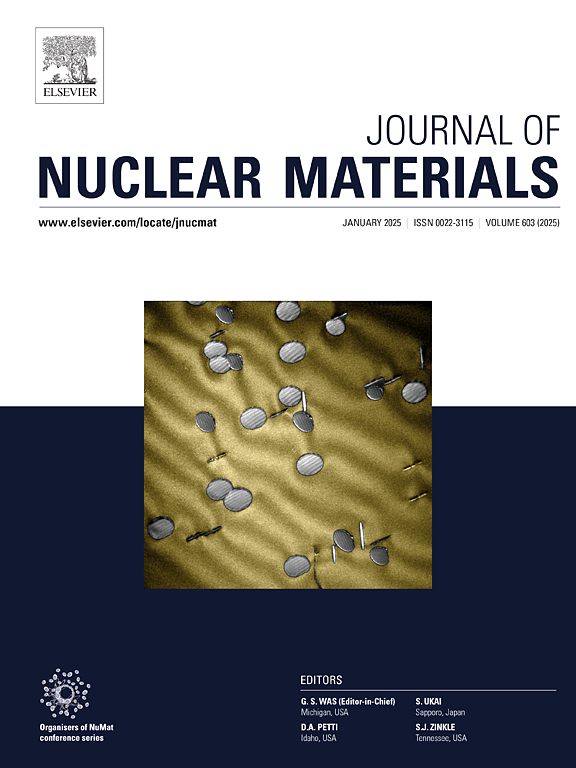Helium ion irradiation-induced hardening behavior in Ti1.5ZrHf0.5Nb0.5Ta0.5 refractory high-entropy alloys
IF 2.8
2区 工程技术
Q3 MATERIALS SCIENCE, MULTIDISCIPLINARY
引用次数: 0
Abstract
Refractory high-entropy alloys (RHEAs) have emerged as the focus in the development of the first wall materials for advanced nuclear energy systems due to their outstanding high-temperature properties and irradiation resistance. However, there remains of profound research and model on the irradiation hardening behavior of refractory high-entropy alloys. In this study, Ti1.5ZrHf0.5Nb0.5Ta0.5 RHEA was subjected to 160 keV room-temperature helium ion irradiation at the doses of 0.1 dpa, 1 dpa, and 3 dpa, then the irradiation hardening behavior was analyzed by nanoindentation experiments. The results indicate that the alloys not only exhibit good strength-ductility synergy at room temperature but also possesses excellent resistance to irradiation hardening. X-ray diffraction (XRD) analysis revealed that the alloy maintained a single-phase body-centered cubic (BCC) structure after irradiation. The lattice constant exhibits an initial decrease at 0.1 dpa followed by an increase from 1 dpa to 3dpa. This is attributed to the competition between lattice relaxation and defect volume expansion. The alloys exhibited a hardening of 34.33% at the maximum irradiation dose. We utilize the plastic zone proportion factor f to reflect the plastic localization caused by irradiation defects. This factor is defined as the ratio of the radius of the plastic zone beneath the indenter after irradiation to the radius before irradiation. By separating the contribution of irradiation hardening using an irradiation hardening model, the plastic zone proportion factor f of the nanoindentation testing decreased from 1.65 to 1.32, suggesting that the increase in irradiation defects hindered the expansion of the plastic deformation volume in the alloy. Consequently, the peak of irradiation hardening shifts towards deeper depths. This study could provide an effective reference for quantifying the irradiation hardening behavior of refractory high-entropy alloys.
Ti1.5ZrHf0.5Nb0.5Ta0.5难熔高熵合金的氦离子辐照硬化行为
耐火高熵合金(RHEAs)由于其优异的高温性能和耐辐照性能,已成为先进核能系统首批壁材开发的热点。然而,对难熔高熵合金辐照硬化行为的研究和建立模型还有待深入。本研究将Ti1.5ZrHf0.5Nb0.5Ta0.5 RHEA分别以0.1 dpa、1 dpa和3 dpa的剂量进行160 keV室温氦离子辐照,并通过纳米压痕实验分析辐照硬化行为。结果表明,该合金在室温下不仅具有良好的强度-塑性协同作用,而且具有优异的抗辐照硬化性能。x射线衍射(XRD)分析表明,辐照后合金保持单相体心立方(BCC)结构。晶格常数在0.1 dpa时开始减小,然后从1 dpa增加到3dpa。这是由于晶格松弛和缺陷体积膨胀之间的竞争。在最大辐照剂量下,合金的硬化率为34.33%。我们利用塑性区比例因子f来反映辐照缺陷引起的塑性局部化。该系数定义为辐照后压头下方塑性区半径与辐照前半径之比。采用辐照硬化模型分离辐照硬化的贡献后,纳米压痕试验的塑性区比例因子f从1.65降至1.32,表明辐照缺陷的增加阻碍了合金塑性变形体积的扩大。因此,辐照硬化峰向更深的深度偏移。该研究可为量化难熔高熵合金的辐照硬化行为提供有效参考。
本文章由计算机程序翻译,如有差异,请以英文原文为准。
求助全文
约1分钟内获得全文
求助全文
来源期刊

Journal of Nuclear Materials
工程技术-材料科学:综合
CiteScore
5.70
自引率
25.80%
发文量
601
审稿时长
63 days
期刊介绍:
The Journal of Nuclear Materials publishes high quality papers in materials research for nuclear applications, primarily fission reactors, fusion reactors, and similar environments including radiation areas of charged particle accelerators. Both original research and critical review papers covering experimental, theoretical, and computational aspects of either fundamental or applied nature are welcome.
The breadth of the field is such that a wide range of processes and properties in the field of materials science and engineering is of interest to the readership, spanning atom-scale processes, microstructures, thermodynamics, mechanical properties, physical properties, and corrosion, for example.
Topics covered by JNM
Fission reactor materials, including fuels, cladding, core structures, pressure vessels, coolant interactions with materials, moderator and control components, fission product behavior.
Materials aspects of the entire fuel cycle.
Materials aspects of the actinides and their compounds.
Performance of nuclear waste materials; materials aspects of the immobilization of wastes.
Fusion reactor materials, including first walls, blankets, insulators and magnets.
Neutron and charged particle radiation effects in materials, including defects, transmutations, microstructures, phase changes and macroscopic properties.
Interaction of plasmas, ion beams, electron beams and electromagnetic radiation with materials relevant to nuclear systems.
 求助内容:
求助内容: 应助结果提醒方式:
应助结果提醒方式:


